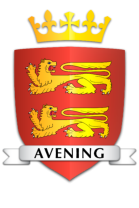

© Avening Parish Council 2023
“Preserve, Conserve, Enhance”
36 Frederick Tanner
Private: 1st Battalion Worcestershire Regiment Fred Tanner, born in Marston Meysey in 1900, was conscripted after his 18th birthday, joining the Worcestershire Regiment. He did his initial training at Sittingbourne in Kent and was then sent to France to join the battalion in September. The Germans were in retreat after the fall of the Hindenberg Line in September and a rapid, general advance was made all along the front. Fred's first taste of the front line came early in October, 1918 when the battalion was occupying old German trenches between Oppy and Gavrelle, northern France. He was in "C" Company which, on the night of the 6th/7th of October, was in the support trenches behind their colleagues of "B" Company whose task was to clear the forward trenches of enemy machine gunners. "D" Company took over the front and continued the slow but steady progress through the trenches but ran out of bombs and ammunition, and "C" Company moved forward to take over. They had success, finally clearing their portion of the trenches and were relieved by other battalions of the Division. On the 12th, the 2nd Battalion Northamptonshires was in the front line and had pushed forward until, once again, the enemy became more resistant. By the 13th, the Northamptonshires could make no further progress and were relieved by Fred's battalion. Let the War Diaries take over here: "A" Company crossed the road and advanced in the failing light towards the village of Flers. Behind them followed "C" Company. As the Worcestershire platoons passed through, the 2nd Northamptonshires assembled in the gathering darkness and marched back into reserve......"A" Company had carried out their allotted task; "C" Company were now to go through to the line of the Haute Deule Canal. An advance at night is never easy. At 8.30pm a strong patrol went forward to the canal bank and a skirmish with a party of Germans ended in the enemy's hurried retirement. The Company boldly pursued and crossed the canal by a railway bridge. The enemy again retired. The patrol re-crossed the bridge and reconnoitred the wood on the western bank of the canal. The remainder of "C" Company was called forward to take up position in the wood and here difficulties made themselves known. Ten foot high wire entanglements had to be overcome and, as the ground was so swampy, digging-in newly dug trenches more than two feet deep immediately filled with water. As dawn broke on the 14th, the enemy's guns opened up all along the front. Shells struck in every direction......but the main force of the bombardment was concentrated upon the wood on the canal bank and it was soon realised that the position of "C" Company was very dangerous. The enemy on the opposite bank had been reinforced and was strongly posted in good cover. The wood itself was open and afforded little protection and from the roof of a large factory on the opposite bank a group of German machine-guns swept the shallow trenches. A withdrawal was forced upon "C" Company but urgent support was required to assist them. "A" Company's Lewis Gunners came forward to check any enemy pursuit. But the remnants of “C" Company suffered terribly whilst crossing the half-mile of shell-swept open ground and only a few groups of survivors reached cover among the ruins of Flers. After the retreat of "C" Company the fighting died down but the Battalion’s losses had been severe. Over 100 in all of dead, missing and wounded. The Battalion was not relieved and for two days fretted in inaction whilst heavy guns were brought up. Enemy artillery continued throughout the day of the 15th but the next day the shelling died down and the night of the 16th/17th was quiet. On the morning of the 18th the advance was begun. The area was "cleared of the Bosche".........Early next morning, the Sherwood Foresters came up through the outpost line and continued the pursuit, the 1st Worcestershires moved back and the Battalion concentrated in Anhiers for a well-earned rest." This was their last engagement of the War but Fred was one of the eleven men killed on Wednesday the 14th of October. He is buried at Douai British Cemetery, Cuincy, Northern France along with his comrades who were killed the same day. He is in plot F22 and lies beside Private Cox aged 19 (F21) and Ernest Coleman aged 17 (F22). He died just 28 days before the Armistice. Fred was unmarried and his father, William Tanner of Nags Head, received his son's two medals after the war.
AveningArchive
WW1 Heroes





© Avening Parish Council 2023
AveningArchive
WW1 Heroes
36 Frederick Tanner
Private: 1st Battalion Worcestershire Regiment Fred Tanner, born in Marston Meysey in 1900, was conscripted after his 18th birthday, joining the Worcestershire Regiment. He did his initial training at Sittingbourne in Kent and was then sent to France to join the battalion in September. The Germans were in retreat after the fall of the Hindenberg Line in September and a rapid, general advance was made all along the front. Fred's first taste of the front line came early in October, 1918 when the battalion was occupying old German trenches between Oppy and Gavrelle, northern France. He was in "C" Company which, on the night of the 6th/7th of October, was in the support trenches behind their colleagues of "B" Company whose task was to clear the forward trenches of enemy machine gunners. "D" Company took over the front and continued the slow but steady progress through the trenches but ran out of bombs and ammunition, and "C" Company moved forward to take over. They had success, finally clearing their portion of the trenches and were relieved by other battalions of the Division. On the 12th, the 2nd Battalion Northamptonshires was in the front line and had pushed forward until, once again, the enemy became more resistant. By the 13th, the Northamptonshires could make no further progress and were relieved by Fred's battalion. Let the War Diaries take over here: "A" Company crossed the road and advanced in the failing light towards the village of Flers. Behind them followed "C" Company. As the Worcestershire platoons passed through, the 2nd Northamptonshires assembled in the gathering darkness and marched back into reserve......"A" Company had carried out their allotted task; "C" Company were now to go through to the line of the Haute Deule Canal. An advance at night is never easy. At 8.30pm a strong patrol went forward to the canal bank and a skirmish with a party of Germans ended in the enemy's hurried retirement. The Company boldly pursued and crossed the canal by a railway bridge. The enemy again retired. The patrol re-crossed the bridge and reconnoitred the wood on the western bank of the canal. The remainder of "C" Company was called forward to take up position in the wood and here difficulties made themselves known. Ten foot high wire entanglements had to be overcome and, as the ground was so swampy, digging-in newly dug trenches more than two feet deep immediately filled with water. As dawn broke on the 14th, the enemy's guns opened up all along the front. Shells struck in every direction......but the main force of the bombardment was concentrated upon the wood on the canal bank and it was soon realised that the position of "C" Company was very dangerous. The enemy on the opposite bank had been reinforced and was strongly posted in good cover. The wood itself was open and afforded little protection and from the roof of a large factory on the opposite bank a group of German machine-guns swept the shallow trenches. A withdrawal was forced upon "C" Company but urgent support was required to assist them. "A" Company's Lewis Gunners came forward to check any enemy pursuit. But the remnants of “C" Company suffered terribly whilst crossing the half-mile of shell- swept open ground and only a few groups of survivors reached cover among the ruins of Flers. After the retreat of "C" Company the fighting died down but the Battalion’s losses had been severe. Over 100 in all of dead, missing and wounded. The Battalion was not relieved and for two days fretted in inaction whilst heavy guns were brought up. Enemy artillery continued throughout the day of the 15th but the next day the shelling died down and the night of the 16th/17th was quiet. On the morning of the 18th the advance was begun. The area was "cleared of the Bosche".........Early next morning, the Sherwood Foresters came up through the outpost line and continued the pursuit, the 1st Worcestershires moved back and the Battalion concentrated in Anhiers for a well-earned rest." This was their last engagement of the War but Fred was one of the eleven men killed on Wednesday the 14th of October. He is buried at Douai British Cemetery, Cuincy, Northern France along with his comrades who were killed the same day. He is in plot F22 and lies beside Private Cox aged 19 (F21) and Ernest Coleman aged 17 (F22). He died just 28 days before the Armistice. Fred was unmarried and his father, William Tanner of Nags Head, received his son's two medals after the war.


























